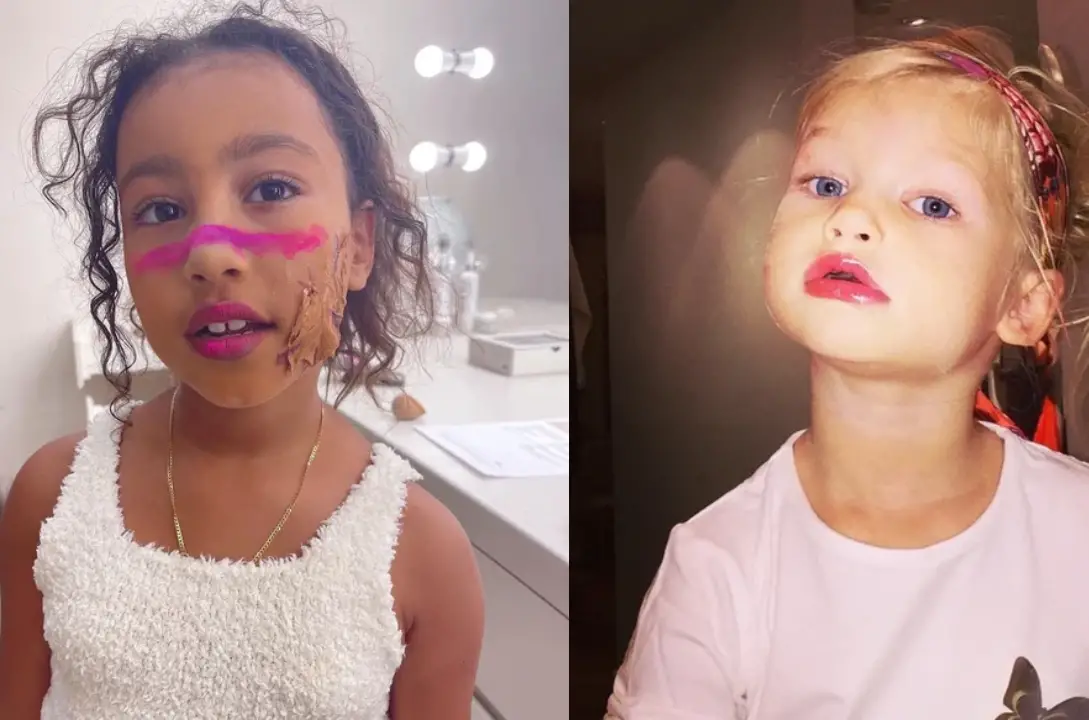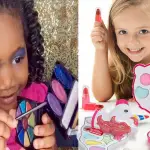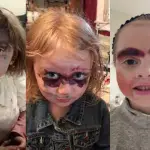Have you ever wondered how to explain makeup to a child? It’s a common question among parents, especially as their little ones start expressing interest in beauty and cosmetics.
If, as a parent or guardian, you once wondered how to explain makeup to a child, this is your guide to a better explanation.
From personal knowledge, his question often arises when children become curious about makeup, whether they see it on TV, in magazines, or on their friends.
Explaining makeup to a child is not just about teaching them about products; it’s about fostering a positive relationship with beauty, self-expression, and self-esteem.
Makeup can be a fun and creative way for children to express themselves. Still, it’s important to introduce it in a way that’s age-appropriate and fosters a healthy relationship with beauty.
If I want to explain makeup to a child, I will say something like this: Makeup is like a special paint used to make themselves feel pretty or different. It’s like adding colours to a picture to make it more interesting. Sometimes, people use makeup to cover up things they don’t like about their appearance or to make themselves feel more confident.
This is just a tip on explaining makeup to a young child; further in this guide, I will guide you through the steps to make this conversation engaging and informative for you and your child.
The Importance of Open Communication
When it comes to discussing makeup with children, open communication is vital. Kids are naturally curious and often want to understand the world around them.
They may question whether they see a parent or older sibling using makeup. You can address their curiosities positively and informally by fostering an environment where they feel comfortable asking questions.
Open dialogue also helps dispel myths or misunderstandings about makeup. Kids may think that makeup is only for adults or something to be ashamed of.
Instead of shutting down their questions, please encourage them to express their thoughts. This allows you to clarify misconceptions and introduce them to the idea that makeup can be a fun and creative tool.
Moreover, discussing makeup openly can help you gauge your child’s interests and feelings about beauty. If they wear makeup, you can assess whether they are ready for it and what pages -are appropriate. Remember, this conversation isn’t just about makeup; it’s about building trust and understanding.
Age-Appropriate Explanations
When explaining makeup to a child, you must tailor your approach based on their age and understanding. Younger children, for example, may not grasp complex concepts but will appreciate simple, straightforward explanations.
You could start by saying that makeup is a fun tool that some people use to enhance their features and express themselves. This lays the groundwork for more in-depth discussions as they grow.
For preschoolers and younger children, focus on the idea that makeup can be playful. You might say, “Makeup is like colouring, where you can add bright colours and sparkles to your face.” This playful explanation can help them see makeup as a form of art rather than something that defines beauty.
As children reach their pre-teen years, they become more aware of societal standards and may have seen peers using makeup.
At this stage, discussing makeup’s purpose and function is essential. While makeup can be fun, it’s also a choice; not everyone wears it. Please encourage them to think critically about why they want to wear makeup and its meaning.
In conversations with teenagers, delve into makeup’s cultural and social aspects. Discuss how makeup can be a way to express individuality but also address the pressure they might feel to conform to beauty standards. Please encourage them to use makeup in a way that feels authentic to themselves.
The Basics of Makeup
Understanding the basics of makeup can help demystify it for children. Start by introducing them to different types of makeup products and their purposes. Explain that makeup can include foundation, blush, eye shadow, mascara, and lip gloss; each serves a unique role.
You can simplify this by saying that foundation helps even skin tone, blush adds a rosy glow, and lip gloss gives shine to the lips.
Using visual aids can make this explanation even more engaging. If you have a makeup bag, consider showing them the products. Let them touch the containers and see the different colours. This hands-on approach can spark their interest and make the conversation more interactive.
Discuss how makeup can enhance features and how it can be easily washed off. Reinforce the idea that makeup is not permanent; it can be fun to experiment with different looks and styles without any long-term commitment. This perspective can help reduce any anxiety they may have about using makeup.
You might also introduce the concept of “minimal makeup” for younger children, including things like tinted lip balm or a sparkly eye shadow for special occasions—emphasizing the idea of makeup as something to be used creatively rather than as a necessity can help children build a healthy relationship with it.
Safety First: Tips for Responsible Makeup Use
As children start to express interest in makeup, it’s crucial to prioritize safety. Makeup safety involves educating them about product ingredients, application techniques, and hygiene practices. Begin by explaining that some products may contain chemicals that could irritate their skin. Teach them to read labels and avoid products with harsh ingredients.
Demonstrate proper application techniques if they want to try using makeup. Show them how to use tools like brushes and sponges safely.
Explain that sharing makeup can lead to infections, so they should always use their products. You can emphasize that hygiene is essential, like washing hands before eating.
Encourage children to start with simple products that are safe for their age group, like natural or hypoallergenic makeup designed for kids.
Brands like “Little Cosmetics” offer realistic makeup for children that is non-toxic and easy to remove, making them perfect for little hands learning the ropes.
Finally, rules should be established regarding when and where makeup can be applied. For instance, they might wear makeup at home or during special occasions but not at school unless a special event calls for it. This approach sets boundaries while allowing them to explore their creativity.
Makeup as a Form of Self-Expression
Makeup can be an excellent form of self-expression, allowing individuals to showcase their personalities. Please discuss with your child how they can use makeup creatively.
This could include experimenting with different colours or styles that reflect their mood or personality. Explain that makeup can help tell a story, like dressing up for a play or creating art.
Please encourage them to think about how they can express themselves through makeup. They might want to try a bold lip colour one day, and a subtle, natural look the next. This freedom allows them to embrace their individuality and develop a personal style.
You could also explore cultural aspects of makeup with them. Share how different cultures use makeup for celebrations, rituals, or personal expression. This can broaden their understanding and appreciation of makeup as a global practice rather than a solitary one.
By fostering a creative approach to makeup, you can help your child see it as a fun tool for self-expression rather than something they need to rely on for validation. Please encourage them to enjoy playing with colours and styles without fear of judgment.
Addressing Common Concerns
Children may have various concerns or questions about makeup, and addressing these openly is essential. For instance, they may worry about being judged by peers for wearing makeup or feel pressure to conform to specific beauty standards. Validate their feelings by acknowledging that it’s normal to have these concerns.
Please encourage your child to express their thoughts and feelings about makeup. If they’re worried about looking “too made up” or fear that others might think they’re trying to be someone they’re not, reassure them that makeup should reflect who they are, not someone else. Help them understand that wearing makeup lightly or not at all is perfectly fine.
Discuss the societal expectations around beauty and how these can affect self-esteem. Emphasize that true beauty comes from within and that makeup is one of many ways to express oneself. Reinforce the importance of feeling comfortable in their skin, regardless of what others think.
Addressing common concerns can help your child build resilience and confidence. Teach them that makeup can be fun but shouldn’t define their worth. Encouraging open dialogue allows them to feel supported in their exploration of makeup.
Encouraging Natural Beauty
As you guide your child in understanding makeup, it’s essential to reinforce the idea of natural beauty. Discuss the importance of self-acceptance and appreciation for their unique features. You might say, “Makeup is just a fun way to enhance what’s already beautiful about you.”
Please encourage them to embrace their natural look by celebrating their features without makeup. Have makeup-free days where they can focus on skincare and self-care instead. This approach teaches them that beauty is not solely dependent on makeup but comes from self-confidence and self-love.
Introduce them to positive role models who promote natural beauty. This could include influencers, celebrities, or even family members who emphasize the importance of self-acceptance. Share stories of individuals who embrace their natural looks, reinforcing that they don’t need makeup to be beautiful.
By nurturing this understanding, you help your child develop a healthy relationship with their appearance. They’ll learn to appreciate their unique features and use makeup as an enhancement rather than a mask. This foundation can foster lasting self-esteem and confidence as they grow.
Conclusion
In conclusion, when considering how to explain makeup to a child, it’s all about fostering an open, honest dialogue that encourages creativity and self-expression. Start by discussing the basics of makeup and its potential as a fun tool for self-enhancement. Prioritize safety and hygiene and help them understand that makeup should be a choice, not a requirement.
Encourage children to explore makeup in a way that feels authentic and reflects their personality. Remind them that true beauty shines from within and that makeup is one of many ways to express who they are. By approaching the topic with care and understanding, you can help your child develop a healthy, positive relationship with makeup that lasts a lifetime.
Integrating these ideas into your conversations will equip your child with the knowledge and confidence to approach makeup thoughtfully and responsibly. So, as you embark on this journey together, remember to enjoy the process and celebrate each step along the way!



